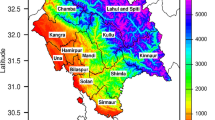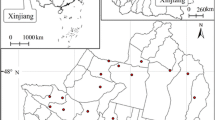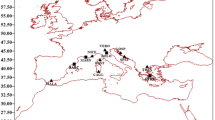Abstract
Precipitation and temperature are the most important meteorological parameters and their quantitative measurement at various return periods is one of the key inputs in the design of various hydraulic structures in diverse contexts. The present research focuses on statistical modelling of monthly maximum precipitation and temperature in the western Indian Himalayan state, Uttarakhand, over the last century (1901–2002), applying extreme value theory (EVT). EVT is an excellent statistical tool to interpret the records to estimate the future probability of the occurrence of extremities. In addition, return levels are used to forecast the likelihood of extremes of the stated meteorological parameters occurring once every 50, 100, 200, 300, and 500 years. The primary goal of this research is to provide statistical information on the behaviour of extreme temperatures and precipitation that will be useful to disaster management organisations and government policymakers in determining appropriate risk mitigation measures for the natural disaster-prone Indian Himalayan state of Uttarakhand.










Similar content being viewed by others
References
Arreyndip N A and Joseph E 2015 Extreme temperature forecast in Mbonge, Cameroon through return level analysis of the generalised extreme value (GEV) distribution; Int. J. Math. Phys. Sci. 9(6) 347–352.
Ayuketang Arreyndip N and Joseph E 2016 Generalised extreme value distribution models for the assessment of seasonal wind energy potential of Debuncha, Cameroon; J. Renew. Energ. 2016 1–9, https://doi.org/10.1155/2016/9357812.
Beguería S and Vicente-Serrano S M 2006 Mapping the hazard of extreme rainfall by peaks over threshold extreme value analysis and spatial regression techniques; J. Appl. Meteorol. Climatol. 45 108–124, https://doi.org/10.1175/JAM2324.1.
Chikobvu D and Chifurira R 2015 Modelling of extreme minimum rainfall using generalised extreme value distribution for Zimbabwe; South Afr. J. Sci. 111 1–8, https://doi.org/10.17159/sajs.2015/20140271.
Gandhre N 2020 Analysis of precipitation extremes for coastal Districts of Maharashtra; Proceedings of the International Conference on Recent Advances in Computational Techniques (IC-RACT) 2020.
Gilleland E and Katz R W 2016 ExtRemes 2.0: An extreme value analysis package in R; J. Stat. Softw. 72, https://doi.org/10.18637/jss.v072.i08.
Hasan H B, Ahmad Radi N F B and Kassim S B 2012 Modeling of extreme temperature using generalised extreme value (GEV) distribution: A case study of Penang; Lecture Notes in Eng. Comput. Sci. 2197 181–186.
Huang W K, Stein M L, McInerney D J, Sun S and Moyer E J 2016 Estimating changes in temperature extremes from millennial-scale climate simulations using generalised extreme value (GEV) distributions; Adv. Stat. Climatol. Meteorol. Oceanogr. 2(1) 79–103, https://doi.org/10.5194/ascmo-2-79-2016.
Kumar V, Shanu and Jahangeer 2017 Statistical distribution of rainfall in Uttarakhand, India; Appl. Water Sci. 7 4765–4776, https://doi.org/10.1007/s13201-017-0586-5.
Leadbetter M R 1991 On a basis for ‘Peaks over Threshold’ modeling; Stat. Probab. Lett. 12(4) 357–362, https://doi.org/10.1016/0167-7152(91)90107-3.
Li Y, Cai W and Campbell E P 2005 Statistical modeling of extreme rainfall in southwest Western Australia; J. Climate 18 852–863, https://doi.org/10.1175/JCLI-3296.1.
Mitchell T D and Jones P D 2005 An improved method of constructing a database of monthly climate observations and associated high-resolution grids; Int. J. Climatol. 25 693–712.
Nandargi S, Gaur A and Mulye S S 2016 Hydrological analysis of extreme rainfall events and severe rainstorms over Uttarakhand, India; Hydrol. Sci. J. 61 2145–2163, https://doi.org/10.1080/02626667.2015.1085990.
Naveau P, Nogaj M, Ammann C, Yiou P, Cooley D and Jomelli V 2005 Méthodes statistiques pour l’analyse des extrêmes climatiques; Comptes Rendus – Geosci. 337 1013–1022, https://doi.org/10.1016/j.crte.2005.04.015.
Negi M S and Kumar A 2016 Assessment of increasing threat of forest fires in Uttarakhand, using remote sensing and GIS techniques; Glob. J. Adv. Res. 3(6) 457–468.
Rana N, Sundriyal Y, Sharma S, Khan F, Kaushik S, Chand P and Juyal N et al. 2021 Hydrological characteristics of 7th February 2021 Rishi Ganga Flood: Implication towards understanding flood hazards in higher Himalaya; J. Geol. Soc. India 97(8) 827–835, https://doi.org/10.1007/s12594-021-1781-4.
R Core Team 2020 R: A language and environment for statistical computing; R Foundation for Statistical Computing, Vienna, Austria, https://www.R-project.org/.
Reiss R D and Thomas M 2001 Statistical analysis of extreme VALUES with applications to insurance, finance, hydrology and other fields; Technometrics 44 516.
Rydén J 2011 Statistical analysis of temperature extremes in long-time series from Uppsala; Theoret. Appl. Climatol. 105 193–197, https://doi.org/10.1007/s00704-010-0389-1.
Sampson T-A and Kwadwo N A 2018 Statistical modeling of temperature extremes behaviour in Ghana; J. Math. Stat. 14 275–284, https://doi.org/10.3844/jmssp.2018.275.284.
Sasireka K, Suribabu C R and Neelakantan T R 2019 Extreme rainfall return periods using Gumbel and Gamma distribution; Int. J. Recent Technol. Eng. 8 26–29, https://doi.org/10.35940/ijrte.d1007.1284s219.
Sati V P 2022 Glacier bursts-triggered debris flow and flash flood in Rishi and Dhauli Ganga valleys: A study on its causes and consequences; Nat. Hazards Res., https://doi.org/10.1016/j.nhres.2022.01.001.
Seneviratne S I, Nicholls N, Easterling D, Goodess C M, Kanae S, Kossin J and Zwiers F W et al. 2012 Changes in climate extremes and their impacts on the natural physical environment. Managing the risks of extreme events and disasters to advance climate change adaptation; Special Report of the Intergovernmental Panel on Climate Change 9781107025066 109–230, https://doi.org/10.1017/CBO9781139177245.006.
Shekhar M S, Pattanayak S and Mohanty U C 2015 A study on the heavy rainfall event around Kedarnath area (Uttarakhand ) on 16 June 2013 7 1531–1544.
Stephenson M A 2018 Package ‘evd’.
Sunday S B, Agog N S, Magdalene P, Mubarak A and Anyam G K 2020 Modeling extreme rainfall in Kaduna using the generalised extreme value distribution; Sci. World J. 15 73–77.
Wilson Moseki Thupeng 2019 Statistical modelling of annual maximum rainfall for Botswana using extreme value theory; Int. J. Appl. Math. Stat. Sci. (IJAMSS) 8 1–10.
Yozgatlıgil C and Türkeş M 2018 Extreme value analysis and forecasting of maximum precipitation amounts in the western Black Sea subregion of Turkey; Int. J. Climatol. 38 5447–5458, https://doi.org/10.1002/joc.5738.
Acknowledgements
The dataset is known as CRU TS 2.02 and is available at https://crudata.uea.ac.uk/cru/data/hrg/timm/grid/CRU_TS_2_0_text.html. The authors also acknowledge the availability of data from the India water portal. The authors are thankful to the Uttarakhand State Council for Science and Technology (UCOST) for financial assistance through grant number UCS&T/R&D-11/20-21/19073.
Author information
Authors and Affiliations
Contributions
Chhavi P Pandey: Conceptualization, data analysis, interpretation and draft manuscript preparation; Vineet Ahuja: Data collection, analysis, interpretation, visualisation and manuscript preparation; Lokesh K Joshi: Data interpretation, drafting and critical revision of the article; Hemwati Nandan: Draft preparation, critical revision and final approval of the final version.
Corresponding author
Additional information
Communicated by Parthasarathi Mukhopadhyay
Rights and permissions
About this article
Cite this article
Pandey, C.P., Ahuja, V., Joshi, L.K. et al. Extreme value analysis of precipitation and temperature over western Indian Himalayan State, Uttarakhand. J Earth Syst Sci 132, 48 (2023). https://doi.org/10.1007/s12040-023-02057-6
Received:
Revised:
Accepted:
Published:
DOI: https://doi.org/10.1007/s12040-023-02057-6




